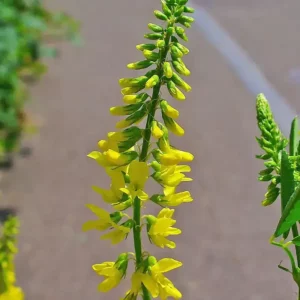+447709283333 | info@damavandpro.com

How to Grow Yellow Sweet Clover
Gardener’s Guide: Grow Yellow Sweet Clover
This vibrant wildflower, yellow sweet clover (Melilotus officinalis), is more than just a splash of sunshine in your garden. It’s a nitrogen-fixing powerhouse, a pollinator magnet, and a versatile green manure crop. Let’s delve into the secrets of cultivating this beneficial wonder, transforming your plot into a haven for both beauty and productivity.
Planting for Success:
- Timing is Key: Spring or fall reigns supreme for sowing yellow sweet clover seeds. Aim for eight weeks after the last frost in spring or six to eight weeks before the first frost in fall. This hardy plant thrives in USDA zones 4 and above.
- Seeding Secrets: Shallower is better! Plant your seeds just ¼ inch deep to ensure optimal germination and seedling emergence.
- Soil Savvy: While adaptable, yellow sweet clover prefers well-draining soil with a neutral to slightly alkaline pH.
Nurturing Champion:
- Moisture Matters: During its first year, consistent moisture is essential for healthy growth. Keep the soil evenly damp, especially during dry spells.
- Let it Shine: Yellow sweet clover thrives in full sun locations. Aim for at least six hours of direct sunlight daily for optimal performance.
- Maintenance Magic: Regular weeding helps your yellow sweet clover seedlings compete for resources. Once established, it generally requires minimal maintenance.
Reaping the Rewards:
- Soil Superhero: As a nitrogen fixer, yellow sweet clover enriches the soil, leaving behind a valuable boost of nitrogen for future plantings.
- Bee Bonanza: Fragrant yellow blossoms attract a multitude of pollinators, including honeybees, essential for a healthy ecosystem.
- Green Manure Marvel: When tilled under, yellow sweet clover adds organic matter, improving soil fertility and structure.
Troubleshooting Tips:
- Low Germination: Ensure proper planting depth and address any moisture issues that might hinder seed emergence.
- Pest Patrol: Keep an eye out for common pests like sitona weevil. Neem oil can be a natural solution for deterring these unwanted visitors.
- Disease Defense: Downy mildew can occasionally affect yellow sweet clover. Maintaining good air circulation around plants and using disease-resistant varieties can help minimize the risk.
Magic of Yellow Sweet Clover:
By incorporating yellow sweet clover into your garden plan, you’re not just adding a touch of beauty – you’re actively contributing to a healthier ecosystem and enriching your soil for future harvests. So, embrace the power of this versatile plant and witness the magic it unfolds in your garden!


Thw blog post on “How to Grow Yellow Sweet Clover” is fantastic! 🌼 It’s clear, informative, and makes the process seem so approachable. Great job! 🌟